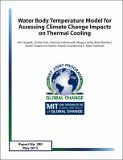| dc.description.abstract | We develop and test a physically based semi-Lagrangian water body temperature model to apply climatological data and thermal pollution from river-based power plants to historical river flow data in order to better understand climate change impacts on surface water temperature and thermal power plant withdrawal allowances. The model is built for rapid assessment and use in Integrated Assessment Models. We first test the standalone model on a 190km river reach, the Delaware River, where we have detailed flow and temperature data. An R2 of 0.88 is obtained on hourly data for this initial test. Next, we integrate the standalone temperature model into a series of models—rainfall-runoff model, water demand model, water resource management model, and power plant uptake and release model—for the contiguous USA (CONUS), with about 19,000 segments total. With this system in place, we then validate the standalone water temperature model within the system for 16 river stations throughout the CONUS, where we have measured daily temperature data. The model performs reasonably well with a median R2 of 0.88. A variety of climate and emissions scenarios are then applied to the model to test regions of higher vulnerability to river temperature environmental violations, making use of output from two GCMs and six emissions scenarios focusing on projections out to 2050. We find that the two GCMs project significantly different impacts to water temperature, driven largely by the resulting changes in streamflow from the two models. We also find significantly different impacts on the withdrawal allowed by thermal power plants due to environmental regulations. Potential impacts on generation are between +3% and -4% by 2050 for the unconstrained emissions case and +3.5% to -2% for the stringent GHG mitigation policy (where 1% is equivalent to 32 TWh, or about 3 billion USD/year using 2005 electricity prices). We also find that once-through cooling plants are most vulnerable to climate change impacts, with summer impacts ranging from -0.8% to -6% for the unconstrained emissions case and +2.1% to -3.7% for the stringent GHG emissions case. | en_US |
